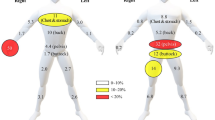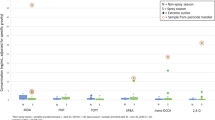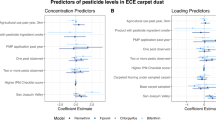Abstract
Epidemiologic studies designed to assess the chronic effects of pesticides are limited by inadequate measurements of exposures. Although cohort studies have been initiated to evaluate the effects of 2,4-dichlorophenoxyacetic acid (2,4-D) and other pesticides in professional turf applicators, they may have limited power to detect significant health risks and may be subject to bias from exposure measurement error. In this study, the doses of 2,4-D, mecoprop [2-(4-chloro-2 methylphenoxy) propionic acid, MCPP] and dicamba (3,6-dichloro-o-anisic acid) were evaluated in a group of 98 professional turf applicators from 20 companies across southwestern Ontario. During a 1-week period (Saturday to Thursday), the volume of pesticide (active ingredient) applied was only weakly related to the total dose of 2,4-D absorbed (R2=0.21). Two additional factors explained a large proportion of variation in dose: the type of spray nozzle used and the use of gloves while spraying. Individuals who used a fan-type nozzle had significantly higher doses than those who used a gun-type nozzle. Glove use was associated with significantly lower doses. Job satisfaction and current smoking influenced the dose but were not highly predictive. In the final multiple regression models predicting total absorbed dose of 2,4-D and mecoprop, approximately 63–68% of the variation was explained. The future application of these models for epidemiologic research will depend on the availability of information and records from employers, the feasibility of contacting study subjects and cost.
This is a preview of subscription content, access via your institution
Access options
Subscribe to this journal
Receive 6 print issues and online access
$259.00 per year
only $43.17 per issue
Buy this article
- Purchase on Springer Link
- Instant access to full article PDF
Prices may be subject to local taxes which are calculated during checkout

Similar content being viewed by others
Abbreviations
- 2, 4-D:
-
2, 4,-dichlorophenoxyacetic acid
- 2, 45-TP:
-
2, 4, 5-trichlorophenoxypropanoic acid
- CV:
-
coefficient of variation
- Dicamba:
-
36-dichloro-o-anisic acid
- DMA:
-
dimethylamine salt
- MCPA:
-
4-chloro-2-methylphenoxyacetic acid
- MCPP:
-
mecoprop, 2-(4-chloro-2 methylphenoxy) propionic acid
- MOEE:
-
Ontario Ministry of Environment and Energy
- MSE:
-
mean squared error
- n :
-
number
- NHL:
-
non-Hodgkin's lymphoma
- OMAFRA:
-
Ontario Ministry of Agriculture, Food and Rural Affairs
- PCOs:
-
professional pest control operators
- RR:
-
relative risk
- SAS:
-
Statistical Analysis System
- SE:
-
standard error
- SMR:
-
standardized mortality ratio
- VIF:
-
variance inflation factor
References
Abbott IM Bonsall JL Chester G Hart TB Turnbull GJ Worker exposure to a herbicide applied with ground sprayers in the United Kingdom Am Ind Hyg Assoc J 1987: 48: 167–175
Adamis Z Antal A Fuzesi I Molnar J Nagy L Susan M Occupational exposure to organophosphorus insecticides and synthetic pyrethroid Int Arch Occup Environ Health 1985: 56: 299–305
Alavanja MC Sandler DP McMaster SB Zahm SH McDonnell CJ Lynch CF Pennybacker M Rothman N Dosemeci M Bond AE Blair A The Agricultural Health Study Environ Health Perspect 1996: 104: 362–369
Armstrong BK White E Saracci R Principles of Exposure Measurement in Epidemiology. Oxford: Oxford Univ. Press 1992
Axelson O Sundell L Andersson K Edling C Hogstedt C Kling H Herbicide exposure and tumor mortality. An updated epidemiologic investigation on Swedish railroad workers Scand J Work Environ Health 1980: 6: 73–79
Blair A Zahm SH Patterns of pesticide use among farmers: implications for epidemiologic research Epidemiology 1993: 4: 55–62
Blair A Hoar Zahm SK Cantor KP Stewart PA Estimating exposure to pesticides in epidemiological studies of cancer. Washington: American Chemical Society
Bloemen LJ Mandel JS Bond GG Pollock AF Vitek RP Cook RR An update of mortality among chemical workers potentially exposed to the herbicide 2,4-dichlorophenoxyacetic acid and its derivatives J Occup Med 1993: 35: 1208–1212
Bond GG Wetterstroem NH Roush GJ McLaren EA Lipps TE Cook RR Cause specific mortality among employees engaged in the manufacture, formulation, or packaging of 2,4-dichlorophenoxyacetic acid and related salts Br J Ind Med 1988: 45: 98–105
Bond GG Bodner KM Cook RR Phenoxy herbicides and cancer: insufficient epidemiologic evidence for a causal relationship Fundam Appl Toxicol 1989: 12: 172–188
Brouwer DH Brouwer EJ van Hemmen JJ Assessment of dermal and inhalation exposure to zineb/maneb in the cultivation of flower bulbs Ann Occup Hyg 1992: 36: 373–384
Bueno de Mesquita HB Doornbos G Van der Kuip DA Kogevinas M Winkelmann R Occupational exposure to phenoxy herbicides and chlorophenols and cancer mortality in the Netherlands Am J Ind Med 1993: 23: 289–300
CCT Expert Panel Report on Carcinogenicity of 2,4-D. Guelph: Canadian Centre for Toxicology
Coggon D Pannett B Winter PD Acheson ED Bonsall J Mortality of workers exposed to 2 methyl-4 chlorophenoxyacetic acid Scand J Work Environ Health 1986: 12: 448–454
Coggon D Pannett B Winter P Mortality and incidence of cancer at four factories making phenoxy herbicides Br J Ind Med. 48: 1991: 173–178
Cowell JE Lottman CM Manning MJ Assessment of lawn care worker exposure to dithiopyr Arch Environ Contam Toxicol. 1991: 21: 195–201
Durkin PR Rubin L Withey J Meylan W Methods of assessing dermal absorption with emphasis on uptake from contaminated vegetation Toxicol Ind Health 1995: 11: 63–79
Eriksson M Hardell L Adami HO Exposure to dioxins as a risk factor for soft tissue sarcoma: a population-based case–control study J Natl Cancer Inst 1990: 82: 486–490
Feldman RJ Maibach HI Percutaneous penetration of some pesticides and herbicides in man Toxicol Appl Pharmacol 1974: 28: 126–132
Fenske RA Correlation of fluorescent tracer measurements of dermal exposure and urinary metabolite excretion during occupational exposure to malathion Am Ind Hyg Assoc J 1988: 49: 438–444
Green LM A cohort mortality study of forestry workers exposed to phenoxy acid herbicides Br J Ind Med 1991: 48: 234–238
Grover R Franklin CA Muir NI Cessna AJ Riedel D Dermal exposure and urinary metabolite excretion in farmers repeatedly exposed to 2,4-D amine Toxicol Lett 1986: 33: 73–83
Harris SA Exposure of homeowners, bystanders and professional applicators to 2,4-dichlorophenoxyacetic acid (2,4-D) MSc Thesis-Guelph: Department of Environmental Biology, University of Guelph 1991 p 85
Harris SA Solomon KR Human exposure to 2,4-D following controlled activities on recently sprayed turf J Environ Sci Health, Part B 1992a: 27: 9–22
Harris SA Solomon KR Percutaneous penetration of 2,4-dichlorophenoxyacetic acid and 2,4-D dimethylamine salt in human volunteers J Toxicol Environ Health 1992b: 36: 233–240
Harris SA Solomon KR Stephenson GR Exposure of homeowners and bystanders to 2,4-dichlorophenoxyacetic acid (2,4-D) J Environ Sci Health, Part B 1992: 27: 23–38
Harris SA Purdham JT Corey PN Sass-Kortsak AM An evaluation of 24-hour urinary creatinine excretion for use in identification of incomplete urine collections and adjustment of absorbed dose of pesticides Am Ind Hyg Assoc J 2000: 61: 649–657
Harris SA Corey PN Sass-Kortsak AM Purdham JT The development of a new method to estimate total daily dose of pesticides in professional turf applicators following multiple and varied exposures in occupational settings Int Arch Occup Environ Health 2001: 74: 345–358
Hoar SK Blair A Holmes FF Boysen CD Robel RJ Hoover R Fraumeni JF Agricultural herbicide use and risk of lymphoma and soft-tissue sarcoma JAMA, J Am Med Assoc 1986: 256: 1141–1147
Hoar Zahm SK Mortality Study of Chemlawn Employees: A Retrospective and Prospective Study. Protocol 1987 Bethesda: National Cancer Institute, Occupational Studies Section
Hoar Zahm SK Personal communication 1996
HSPH The Weight of Evidence on the Human Carcinogenicity of 2,4-D. Boston: Harvard School of Public Health, Program on Risk Analysis and Environmental Health 1990
IARC Occupational exposures to chlorophenoxy herbicides IARC Monogr Eval Carcinog Risk Chem Hum 1986: 41: 357–406
IARC Some halogenated hydrocarbons and pesticide exposures IARC Monogr Eval Carcinog Risk Chem Hum 1986: 41: 319–406
IARC Phenoxy acid herbicides and contaminants: description of the IARC International Register of Workers IARC Work Group Am J Ind Med 1990: 18: 39–45
Ibrahim MA Bond GG Burke TA Cole P Dost FN Enterline PE Gough M Greenberg RS Halperin WE McConnell E Weight of the evidence on the human carcinogenicity of 2,4-D Environ Health Perspect 1991: 96: 213–222
Johnson ES Association between soft tissue sarcomas, malignant lymphomas, and phenoxy herbicides/chlorophenols: evidence from occupational cohort studies Fundam Appl Toxicol 1990: 14: 219–234
Johnson CC Feingold M Tilley B A meta-analysis of exposure to phenoxy acid herbicides and chlorophenols in relation to risk of soft tissue sarcoma Int Arch Occup Environ Health 1990: 62: 513–520
Kamble ST Byers ME Witkowski JF Ogg CL Echtenkamp GW Field worker exposure to selected insecticides applied to corn via center-pivot irrigation J Econ Entomol 1992: 85: 974–980
Karr C Demers P Costa LG Daniell WE Barnhart S Miller M Gallagher G Horstman SW Eaton D Rosenstock L Organophosphate pesticide exposure in a group of Washington State orchard applicators Environ Res 1992: 59: 229–237
Kauppinen TP Pannett B Marlow DA Kogevinas M Retrospective assessment of exposure through modeling in a study on cancer risks among workers exposed to phenoxy herbicides, chlorophenols and dioxins Scand J Work Environ Health 1994: 20: 262–271
Kogevinas M Saracci R Winkelmann R Johnson ES Bertazzi PA Bueno de Mesquita BH Kauppinen T Littorin M Lynge E Neuberger M Cancer incidence and mortality in women occupationally exposed to chlorophenoxy herbicides, chlorophenols, and dioxins Cancer, Causes Control 1993: 4: 547–553
Kogevinas M Becher H Benn T Bertazzi PA Boffetta P Bueno-de-Mesquita HB Coggon D Colin D Flesch-Janys D Fingerhut M Green L Kauppinen T Littorin M Lynge E Mathews JD Neuberger M Pearce N Saracci R Cancer mortality in workers exposed to phenoxy herbicides, chlorophenols, and dioxins. An expanded and updated international cohort study Am J Epidemiol 1997: 145: 1061–1075
Kohli JD Khanna RN Gupta BN Absorption and excretion of 2,4-dichlorophenoxyacetic acid in man Xenobiotica 1974: 4: 61–71
Leavitt JR Gold RE Holcslaw T Tupy D Exposure of professional pesticide applicators to carbaryl Arch Environ Contam Toxicol 1982: 11: 57–62
Lengerich SK Burroughs FG Near real-time monitoring of potential dermal exposure during backpack herbicide spraying Am Ind Hyg Assoc J 1989: 50: 516–519
Lerda D Rizzi R Study of reproductive function in persons occupationally exposed to 2,4-dichlorophenoxyacetic acid (2,4-D) Mutat Res 1991: 262: 47–50
Libich S To JC Frank R Sirons GJ Occupational exposure of herbicide applicators to herbicides used along electric power transmission line right-of-way Am Ind Hyg Assoc J 1984: 45: 56–62
Lynge E Background and design of a Danish cohort study of workers in phenoxy herbicide manufacture Am J Ind Med 1987: 11: 427–437
Lynge E Cancer in phenoxy herbicide manufacturing workers in Denmark, 1947–87 — an update Cancer, Causes Control 1993: 4: 261–272
Mena F Ryks J Lyttle C Determination of Acidic Herbicides in Urine by Ion Trap Mass Spectrometry. Guelph: Ontario Ministry of Agriculture, Food and Rural Affairs, Pesticide and Trace Contaminants Laboratory 1996
Morrison HI Wilkins K Semenciw RM Mao Y Wigle DT Herbicides and cancer J Natl Cancer Inst 1992: 84: 1866–1874
Ott MG Holder BB Olson RD A mortality analysis of employees engaged in the manufacture of 2,4,5-trichlorophenoxyacetic acid J Occup Med 1980: 22: 47–50
Pearce NE Smith AH Howard JK Sheppard RA Giles HJ Teague CA Non-Hodgkin's lymphoma and exposure to phenoxyherbicides, chlorophenols, fencing work, and meat works employment: a case–control study Br J Ind Med 1986: 43: 75–83
PEHD Pesticide Exposure Handlers Database, Reference Manual. Springfield: Versar Inc 1992
Popendorf W Selim M Lewis MQ Exposure while applying industrial antimicrobial pesticides Am Ind Hyg Assoc J 1995: 56: 993–1001
Riihimaki V Asp S Hernberg S Mortality of 2,4-dichlorophenoxyacetic acid and 2,4,5-trichlorophenoxyacetic acid herbicide applicators in Finland: first report of an ongoing prospective cohort study Scand J Work Environ Health 1982: 8: 37–42
Rutz R Krieger RI Exposure to pesticide mixer/loaders and applica-tors in California Rev Environ Contam Toxicol 1992: 129: 121–139
Saracci R Kogevinas M Bertazzi PA Bueno de Mesquita BH Coggon D Green LM Kauppinen T LqAbbe KA Littorin M Lynge E Cancer mortality in workers exposed to chlorophenoxy herbicides and chlorophenols Lancet 1991: 338: 1027–1032
Sauerhoff MW Braun WH Blau GE Gehring PJ The fate of 2,4-dichlorophenoxyacetic acid (2,4-D) following oral administration to man Toxicology 1977: 8: 3–11
Slocum AC Shern LC Spray deposition patterns during simulated work activities by lawn care specialists J Environ Sci Health, Part B 1991: 26: 259–278
Solomon KR Harris SA Stephenson GR Applicator and bystander exposure to home garden and landscape pesticides In: Racke R., and Leslie A. (Eds.) Pesticides in Urban Environments. Washington: American Chemical Society 1993 pp 262–274
Swaen GM van Vliet C Slangen JJ Sturmans F Cancer mortality among licensed herbicide applicators Scand J Work Environ Health 1992: 18: 201–204
Van Hemmen JJ Predictive exposure modelling for pesticide registration purposes Ann Occup Hyg 1993: 37: 541–564
Vineis P Terracini B Ciccone G Cignetti A Colombo E Donna A Maffi L Pisa R Ricci P Zanini E Phenoxy herbicides and soft-tissue sarcomas in female rice weeders. A population-based case-referent study Scand J Work Environ Health 1987: 13: 9–17
WHO 2,4-Dichlorophenoxyacetic Acid. Geneva: World Health Organization 1984
Wigle DT Semenciw RM Wilkins K Riedel D Ritter L Morrison HI Mao Y Mortality study of Canadian male farm operators: Non-Hodgkin's lymphoma mortality and agricultural practices in Saskatchewan J Natl Cancer Inst 1990: 82: 575–582
Zahm SH Mortality study of pesticide applicators and other employees of a lawn care service company J Occup Environ Med 1997: 39: 1055–1067
Zahm SH Weisenburger DD Babbitt PA Saal RC Vaught JB Cantor KP Blair A A case–control study of non-Hodgkin's lymphoma and the herbicide 2,4-dichlorophenoxyacetic acid (2,4-D) in Eastern Nebraska Epidemiology 1990: 1: 349–356
Acknowledgements
We gratefully acknowledge the laboratory and research assistance of Paul Bozek, Alexis Purdham and Craig Johnson. Frank Mena and Brian Ripley analyzed the urine samples for pesticides at the Pesticide and Trace Contaminants Laboratory of the OMAFRA. Further, we appreciate the efforts of Dr. Sheila Hoar-Zahm during proposal preparation and editorial review comments from Drs. Nancy Kreiger, John McLaughlin, Laszlo Endrenyi and Donald Cole. This work was funded by Health Canada through a National Health Research and Development Program Research Grant (project no. 6606-5344-502). The first author was supported with a NHRDP PhD Research Training Award, an Ontario Graduate Scholarship and a University of Toronto Doctoral Fellowship. Although thanking each volunteer in the study is not possible, we recognize their contribution.
Author information
Authors and Affiliations
Corresponding author
Rights and permissions
About this article
Cite this article
HARRIS, S., SASS-KORTSAK, A., COREY, P. et al. Development of models to predict dose of pesticides in professional turf applicators. J Expo Sci Environ Epidemiol 12, 130–144 (2002). https://doi.org/10.1038/sj.jea.7500208
Received:
Published:
Issue Date:
DOI: https://doi.org/10.1038/sj.jea.7500208
Keywords
This article is cited by
-
Predictors of 2,4-dichlorophenoxyacetic acid exposure among herbicide applicators
Journal of Exposure Science & Environmental Epidemiology (2010)
-
Urinary biomarker, dermal, and air measurement results for 2,4-D and chlorpyrifos farm applicators in the Agricultural Health Study
Journal of Exposure Science & Environmental Epidemiology (2010)



